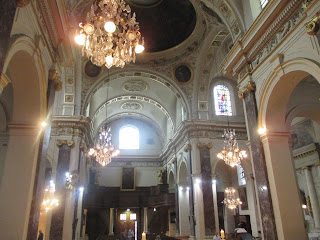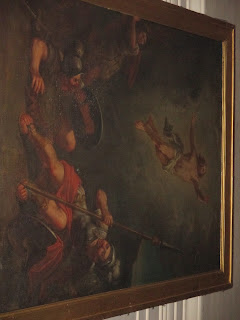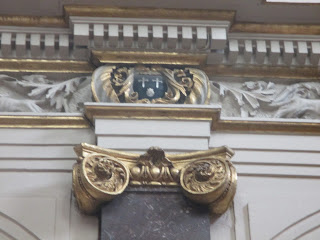You can see me sitting on the 18th century choir or quire, the area of a church or cathedral that provides seating for the clergy and church choir.
France has many beautiful churches. I have so many favorites. Last Summer I attended a wonderful mass at the beautiful Saint-Romain Church of Rouen. In the district of the train station of Rouen. A French friend played the organ there. Originally located outside the city walls when built, it was the chapel of the convent of the Carmes Déchaussés, The first stone of the sanctuary was laid November 20 1643. The church facing the street rue du Champ aux Oiseaux. The father of Blaise Design, prior of the convent, blessed it in 1645 the choir and sacristy. The monastery was founded in 1568 to be removed during the Revolution.
The church was rebuilt in the late xvii the century a north-south direction along the street Field Bird. The first stone was laid in 1679 by the first President of the Court. The dedication of the church was held on December 21 1681 But work continued until 1729. It was at this time that the altar carrying the sculptor Mazeline. Baroque style building, its reconstruction was funded by the Becdelièvre family, represented by the presence of many small rabbits in the decoration of the church.
The first level of the façade has a large portal surrounded by pilasters with Doric capital
and two statues. St. Teresa of Avila and St. Joseph, patron of the order
the upper level, two other statues and St. Jacques Roman accompanied the gargoyle.
The shape of a Greek cross, it is oriented north-south. Its main facade faces the street of La Rochefoucauld. It consists of a large box of niche portal. The two upper niches that frame the central bay greet holy statues Teresa of Avila and St. Joseph, patron of the order
An angel on the platform (gilded)
eighteenth century
The shape of a Greek cross, it is oriented north-south. Its main facade faces the street of La Rochefoucauld. It consists of a large box of niche portal. The two upper niches that frame the central bay greet holy statues Teresa of Avila and St. Joseph, patron of the order
The style of Louis XIV shines in this beautiful church Rouen what Saint-Romain. A floral themed frieze, surmounted by an entablature projecting largely runs through the building, clearly separating the two levels of elevation. The beautiful marble pilasters in red are topped by gilded Ionic capitals. The whole creates a very balanced chromatic contrast with the white cream elevations.
The transept also hosts two altars by the sculptor Bonet. A statue of the Virgin rests on the altar of the left transept while the right houses a statue of Pierre-Julien Eymard , brother of the Blessed Sacrament whose congregation was responsible officer in the church until the start of the Diocese Rouen, the last Congregation of the Blessed Sacrament in August 2013
The altar of the Virgin in Carrara marble in the right transept
The transept also hosts two altars by the sculptor Bonet. A statue of the Virgin rests on the altar of the left transept while the right houses a statue of Pierre-Julien Eymard , brother of the Blessed Sacrament whose congregation was responsible officer in the church until the start of the Diocese Rouen, the last Congregation of the Blessed Sacrament in August 2013
the red marble tomb of St. Romain is enshrined under the high altar of the xix th century, the church Saint-Romain
Detail of confessional
Detail of confessional
Jesus death is down from the cross by his relatives, table of the eighteenth century
Pilgrims to Emmaus
anonymous Table, eighteenth century
The church became a parish during the Revolution. It houses stained glass xvi th - xvii th centuries from abandoned or destroyed churches. 21 of the 24 stained glass windows are from a chapel of the old cemetery of St. Maur, churches St. Martin Renelle and Saint-Étienne-des-Coopers . The other three windows dating from 1868 adorn the chapel of the baptismal font.
The organ, built around 1750 , comes from the church of Saint-Lauren.
The arches of the nave, the choir and transepts are barrel. Cross hosts a cupola , whose paintings depicting key moments in Roman saint's life were painted by Benedict Pécheux.
The arches of the nave, the choir and transepts are barrel. Cross hosts a cupola , whose paintings depicting key moments in Roman saint's life were painted by Benedict Pécheux
The organ, built around 1750 , comes from the church of Saint-Lauren
Medallions of Doctors of the Church
in the vault of the choir of Saint-Romain
Wonderful details of the organ case, built around 1750 , comes from the church of Saint-Lauren
Wonderful details of the organ case, built around 1750 , comes from the church of Saint-Lauren
Medallions of Doctors of the Church
in the vault of the choir of Saint-Romain. Saint Ambrose.
he Roman saint stained glass and its gargoyle
surrounded by a beautiful stucco decoration
of clouds and cherubs
The church became a parish during the Revolution. It houses stained glass xvi th - xvii th centuries from abandoned or destroyed churches. 21 of the 24 stained glass windows are from a chapel of the old cemetery of St. Maur, churches St. Martin Renelle and Saint-Étienne-des-Coopers . The other three windows dating from 1868 adorn the chapel of the baptismal font.
The style of Louis XIV shines in this beautiful church Rouen what Saint-Romain. A floral themed frieze, surmounted by an entablature projecting largely runs through the building, clearly separating the two levels of elevation. The beautiful marble pilasters in red are topped by gilded Ionic capitals. The whole creates a very balanced chromatic contrast with the white cream elevations.
Jesus death is down from the cross by his relatives, table of the eighteenth century
Confessional
Detail of confessional
"The mystery of salvation," anonymous array
Baby Jesus is placed on the cross, under the gaze
of his mother. His gaze turned to the Heavenly Father.
Detail of confessional
Jesus death is down from the cross by his relatives, table of the eighteenth century
Wonderful details of the organ case, built around 1750 , comes from the church of Saint-Lauren
"Saint Ignatius Loyola with the Child before the Virgin"
anonymous Table, seventeenth century
Chapel of the left apse
The altar of the chapel was once the altar of the church
Chapel of the left apse
The altar of the chapel was once the altar of the church
ollowing the holy bishops on the altar of the chapel of the left apse
the tomb of St. Romain is under this altar. His remains were dispersed during the Wars of Religion.
ollowing the holy bishops on the altar of the chapel of the left apse
the tomb of St. Romain is under this altar. His remains were dispersed during the Wars of Religion.
"Carrying the Cross"
table in the left apse chapel, eighteenth century
Chapel of the left apse
The altar of the chapel was once the altar of the church
The transept also hosts two altars by the sculptor Bonet. A statue of the Virgin rests on the altar of the left transept while the right houses a statue of Pierre-Julien Eymard , brother of the Blessed Sacrament whose congregation was responsible officer in the church until the start of the Diocese Rouen, the last Congregation of the Blessed Sacrament in August 2013
The style of Louis XIV shines in this beautiful church Rouen what Saint-Romain. A floral themed frieze, surmounted by an entablature projecting largely runs through the building, clearly separating the two levels of elevation. The beautiful marble pilasters in red are topped by gilded Ionic capitals. The whole creates a very balanced chromatic contrast with the white cream elevations.
The dome of Saint-Romain church
The dome of Saint-Romain church is one of the glories of the building, even if the paintings that adorn it are not always visible. The dome is illustrated four scenes from the life of St. Romain (the Sacre , the preaching , the Miracle of the gargoyle and the Procession of Pride ). Two of them are reproduced below.
As for the name of the painter, the sources vary. It is written in the instructions available in the church that it is Benedict Pescheux (where documentation seems not found). Ditto on Wikipedia. But Edgard Naillon in his 1941 book on the Rouen churches attributes the paintings of the cupola Alexander Amédée Dupuy-Delaroche (1819-1887), a painter also many churches in Seine-Maritime, including Saint-Godard and Saint Clément in Rouen. You have to give reason for it is actually the name of the artist in the lower right of the scene depicting the Coronation of St. Romain . This signature is given below against the right: "DUPUY-DELAROCHE, 1887" . Although seeming absence of any detailed documentation, the name Benedict Pescheux face even when in the work of Edgar Naillon since this author reports - in 1941 - the existence of a fresco painter in the sanctuary. The fresco depicting the Agony of Christ is no longer visible.
We also know who are the characters that appear in the four painted medallions in the spandrels (two of which are shown on the right). We opt for former superiors of the Order of Discalced Carmelites.
The transept also hosts two altars by the sculptor Bonet. A statue of the Virgin rests on the altar of the left transept while the right houses a statue of Pierre-Julien Eymard , brother of the Blessed Sacrament whose congregation was responsible officer in the church until the start of the Diocese Rouen, the last Congregation of the Blessed Sacrament in August 2013
An angel on the platform (gilded)
eighteenth century
Angel Holy water font
Bas-relief with cherubs on the ceiling
above the gallery
An angel on the platform (gilded)
eighteenth century
floral theme scrolls on the frieze church belt
The transept also hosts two altars by the sculptor Bonet. A statue of the Virgin rests on the altar of the left transept while the right houses a statue of Pierre-Julien Eymard , brother of the Blessed Sacrament whose congregation was responsible officer in the church until the start of the Diocese Rouen, the last Congregation of the Blessed Sacrament in August 2013
The cover of the baptismal font, which came from the Saint-Étienne-des-Coopers and transferred to the church in 1802 , is currently at the Museum of Fine Arts
The lead tower was made higher in 1876 to replace the one built in 1806 , following plans of Eugène Barthélémy and under achieving Ferdinand Marrou
The first level of the façade has a large portal surrounded by pilasters with Doric capital
and two statues. St. Teresa of Avila and St. Joseph, patron of the order
the upper level, two other statues and St. Jacques Roman accompanied the gargoyle.






































































































No comments:
Post a Comment